
Btrax Design Company > Freshtrax > Top 5 Social Me...
Top 5 Social Media Platforms in Japan 2019
To be successful in any market, properly marketing your business to the right audience and choosing the right marketing tactics are very important factors to consider. In this age of technology, social media has become a very powerful and popular marketing tool that can reach a large population and a variety of users. However, it is important to remember that each social media platform caters to a different demographic and creates a unique experience for its users.
Known for its unique culture, Japan has quite a few uncommon social media trends that will be discussed in this article that make the Japanese market different from the rest of the world. Therefore, it’s best to be mindful of these trends and which social media platforms Japanese people are using.
In order to give you a better sense of which social media platform you should be using to connect with your Japanese customers, this article will provide an overview of the social media landscape in Japan, the top 5 platforms, and insights on each platform’s users.
The Top 5 Social Media Platforms in Japan
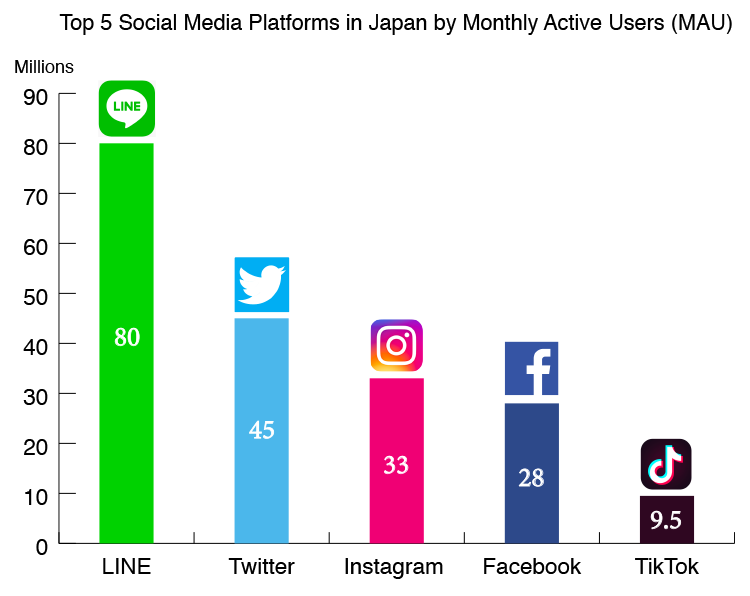
Sources: Techcrunch, Facebook News, MarkeZine
As you can see from the chart above, LINE is the most popular social media platform in Japan followed by Twitter, Instagram, Facebook, and TikTok. When comparing the Monthly Active Users (MAU) of these 5 social media platforms, LINE is obviously the most dominant in the Japanese market. However, it’s important to note that each platform accommodates a different demographic and has its own unique features. So, let’s take a closer look at the differences to help you understand which platform is most suitable for your marketing strategy.
Population of Japan by Age and Gender
Before diving into the details of each social media platform, let’s look at the population of Japan by age and gender to give you a general sense of the market potential.
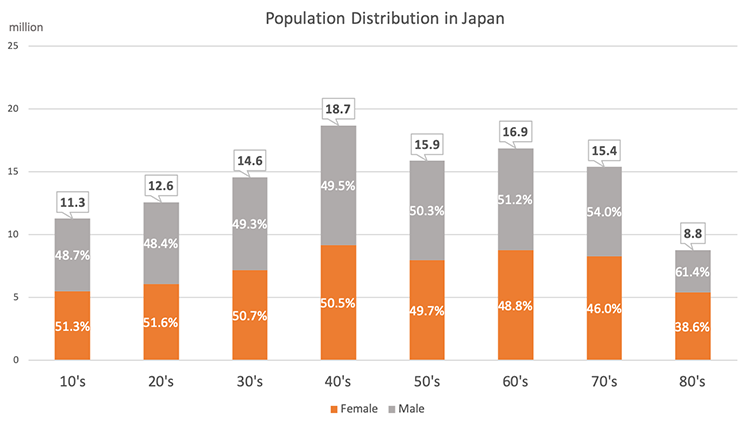
Source: Japanese Statistics Bureau Data (January 2019)
Now, let’s take a closer look at each of the top 5 social media platforms in Japan.
LINE: Much more than just a messaging app
LINE is the most popular social media platform in Japan. It was originally a subsidiary of the Korean company NAVER but is now listed on the Tokyo Stock Exchange/ New York Stock Exchange (with Naver owning 72% of the shares.) Since LINE was released in Japan in 2011, it has significantly increased by MAU.
LINE’s penetration rate is surprisingly high. Actually, it is higher than the smartphone penetration rate in Japan. This is because there are also many non-smartphone users who access LINE from a computer or tablet device. LINE has 80 million MAU compared to the nation’s 70 million smartphone users.
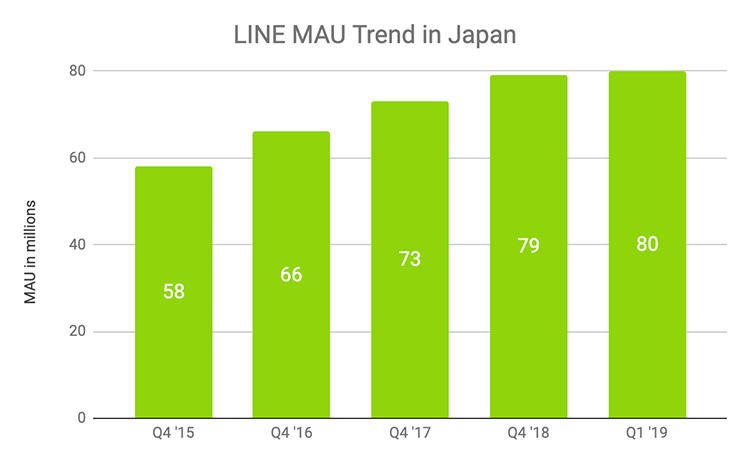
Sources: LINE 2019 Q1, LINE 2018 Q3
Although LINE’s MAU in Japan has continued to grow since its initial release in 2011, its worldwide MAU count has stagnated because three of the four major countries that use LINE have declined in users over the past few years.
In response to the decrease in its worldwide MAU, LINE started to focus on diversifying its business by adding more services such as payment method LINE Pay, LINE Shopping, LINE Brain (A.I. development department), and so on to make itself a foundational tool in Japanese lives.
LINE User Characteristics
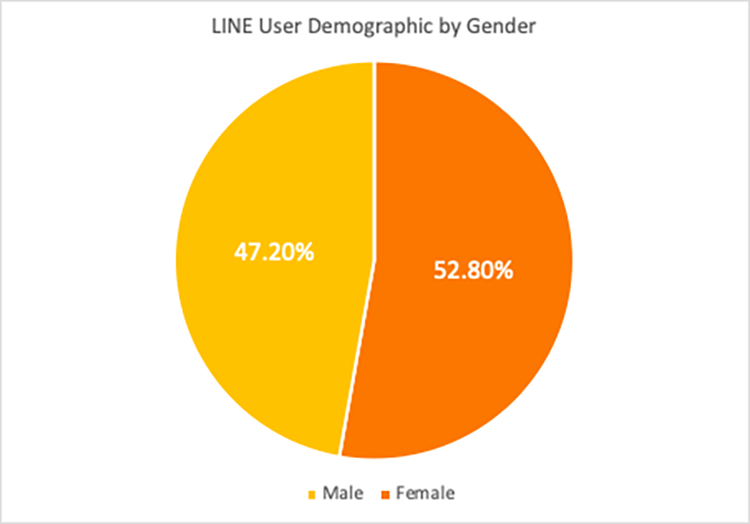
Source: LINE Summary 2019 July to September
As you can see in the graph above, the number of female users is only slightly greater than the number of male users.
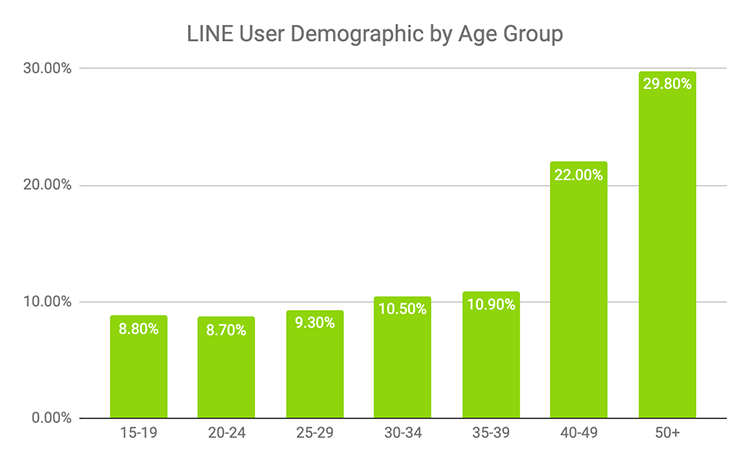
Source: LINE Summary 2019 July to September
The graph above shows the percentage of users in each age group. When compared to the population of Japan (in reference to the chart “Population Distribution in Japan” graph above), we can see that the number of LINE users closely resembles Japan’s population distribution by age group. It is no surprise as LINE has a very high penetration rate within all age groups.
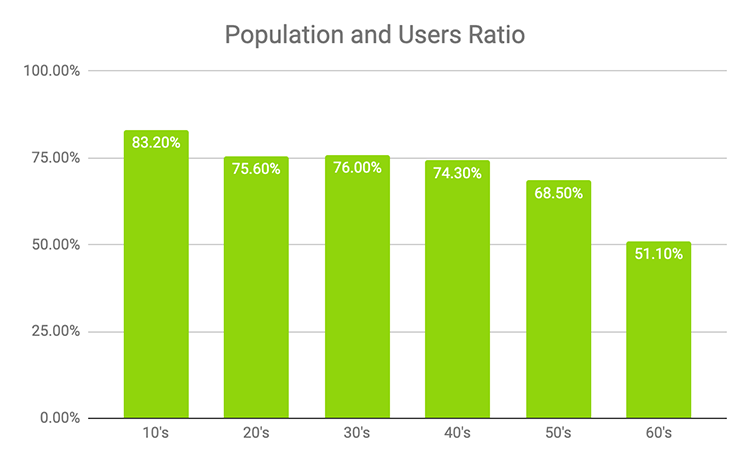
Sources: Social Media Lab by Gaiax, FastaskReport
When we take a closer look at LINE users, we can see that percentage of teens use LINE more than any other age group, even though there are more users who are 40 and above. This is an interesting graph showing that LINE transcends generations and is a good sign for the company with Japan being an aging country.
With this data, we can see that every age group uses LINE frequently, which is why the app has become such a pivotal tool in the digital lives of Japan.
LINE plays a pivotal role in Japanese lives
Originally a simple messaging app for smartphones, LINE implemented mobile games and a news feed to expand its service offerings. Its core services include messaging, its own mobile payment system called LINE Pay, manga, music, and a smart channel that provides content such as news, the weather forecast, fortune-telling, and more.
LINE is also a pioneer of virtual stickers for its messaging app. The virtual stickers are one of LINE’s core services that generates a decent portion of its revenue. Stickers are created by LINE, amateur creators, and companies with each using stickers as one of their marketing tools.
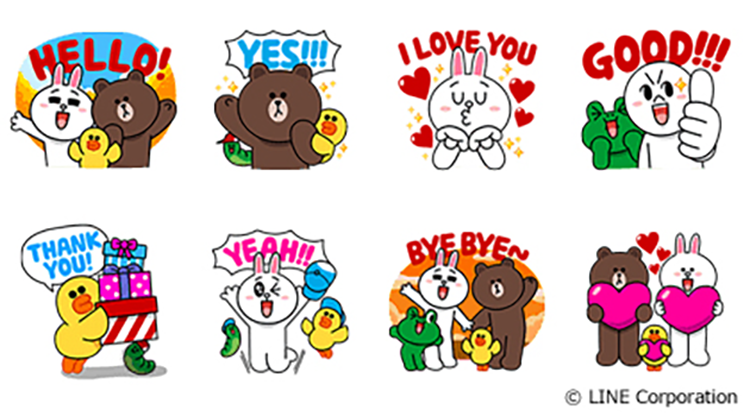
Source: LINE PR News
Above are stickers created by LINE. Below are Minion stickers created by Universal Studios.
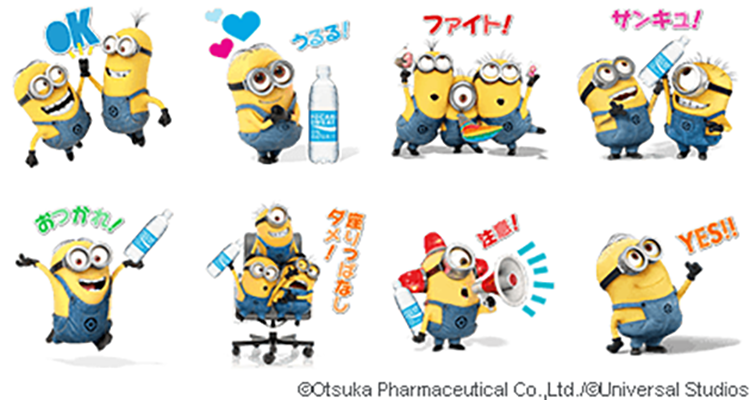
Source: LINE Official Blog
With all these features, LINE has become the central digital community center where the Japanese can connect, gather news, listen to music, and so much more.
LINE Group Chats
LINE group chat rooms are very commonly used in Japan. Many use LINE as an integrated messaging tool to connect with many of their contacts, from family to friends and even co-workers. It’s not rare to have several group chat rooms as a user can create chats with only family or only with co-workers and so on. This is another reason why user engagement is high.
With more than 3 million business accounts, businesses need to be careful with how they are using the app and advertising on it. Frequent promotions from businesses may not receive a good reaction as users prefer to use the app to connect with others. Therefore, there is possibly a high chance a user will block the business from their account if they feel it is too intrusive.
【Related Article】 The Ultimate Guide to Using the LINE APP for Business
Twitter: Owning multiple accounts to connect with different communities
Twitter is very popular in Japan with some of the reasons being because the Japanese can remain anonymous on the platform and convey much more context within the 280 character limit in Japanese than other languages, like English or Spanish. Compared to the American population, 35.7% of Japanese actively use Twitter actively while only 20.7% of Americans actively use Twitter.
Twitter CEO Jack Dorsey saw a rapid increase in MAU in Japan even before Twitter was localized for the Japanese market. This helped him see that Twitter could be a good fit for Japanese culture.
The Japanese version of Twitter was launched in 2008 and its MAU has been increasing since. Now, 17% of Twitter’s worldwide revenue comes from the Japanese market.
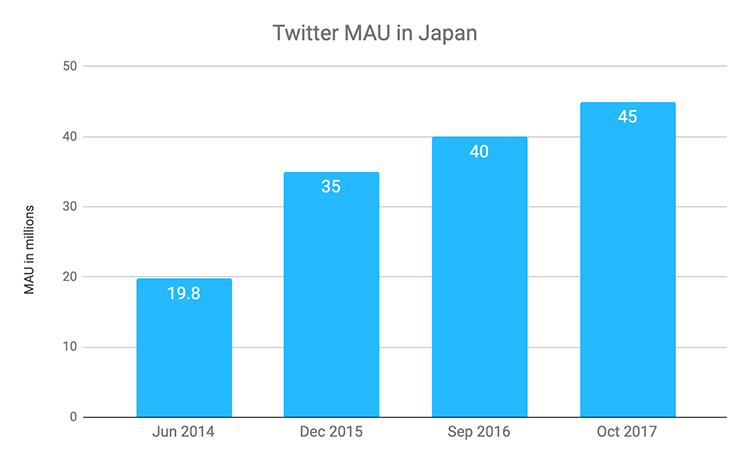
Twitter hasn’t announced its MAU since October 2017. (Source: Twitter Official Account, Huff Post)
Twitter User Characteristics
As you can see in the graph below, the number of male users is slightly greater than the number of female users in most of the older age groups while the number of female users is slightly greater in the younger age groups.
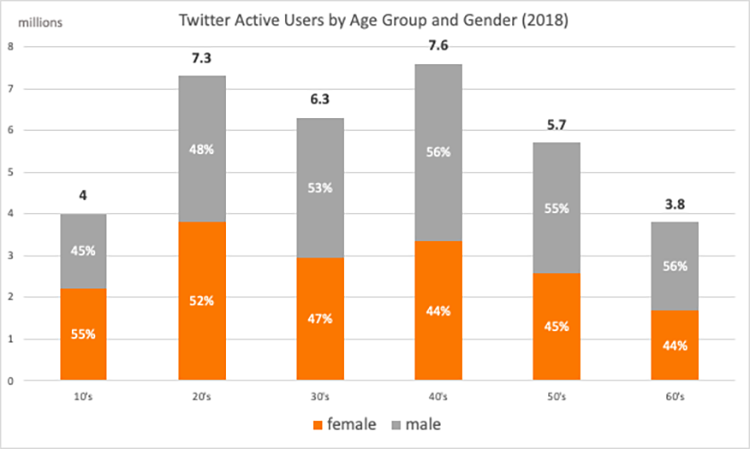
Source: FastaskReport, Social Media Lab
Interestingly, there is almost the same number of users in their 20’s as there are in their 40’s, as illustrated in the graph above. However, in the graph below, we can see that the number of users in their 40’s is much lower than the other age groups in comparison to the population of Japan. This shows that Twitter is especially popular among those in their 20’s. The usage among teens is also remarkably high.
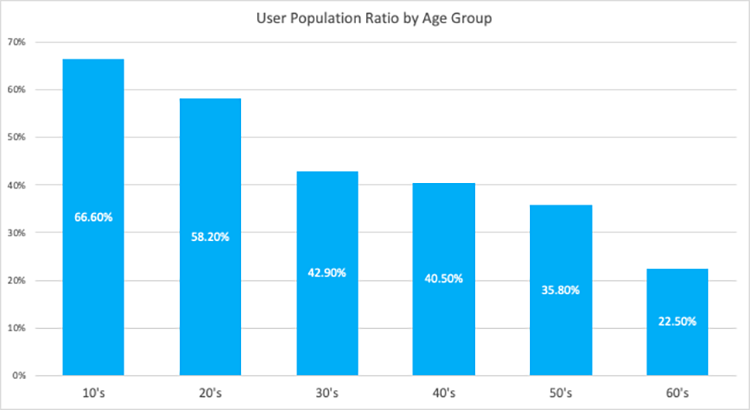
Sources: FastaskReport, Social Media Lab
Creating multiple accounts to connect with different interest groups
Japanese users tend to have multiple Twitter accounts, depending on what they want to see on their feed. Some users only use Twitter to tweet their thoughts, ideas, or send messages to friends, while others use it to collect news and information.
For instance, according to a survey conducted by consulting firm, RISKYBAND, 49% of active users use Twitter to gather information regarding their hobbies and 31% use it to follow the latest news. (You can see the data in the graphs below). These numbers are relatively high compared to other popular social media platforms, such as LINE and Facebook.
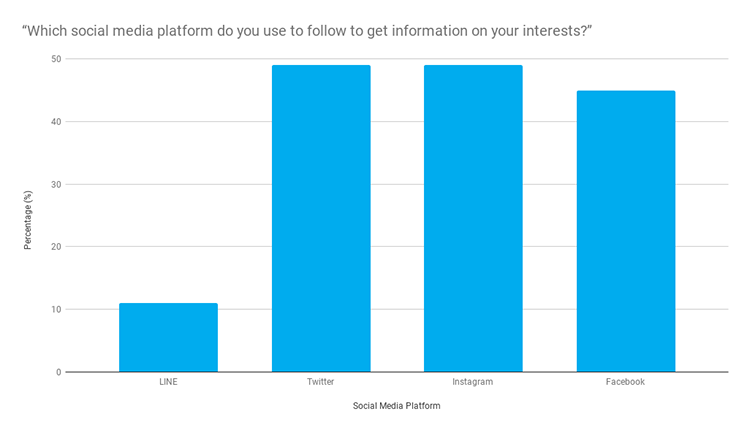
Source: RISKYBRAND
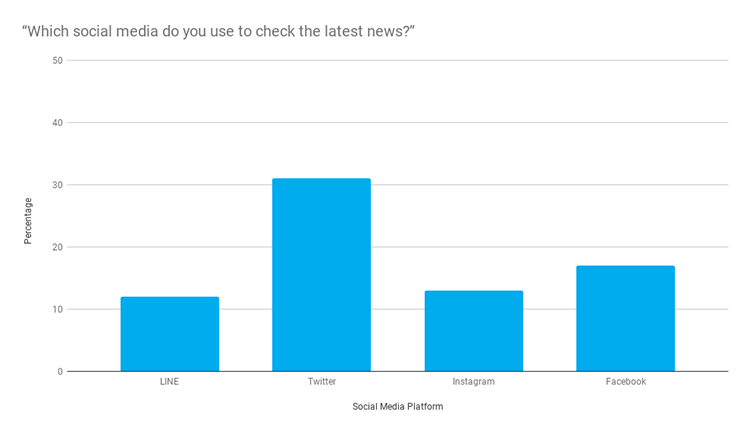
Source: RISKYBRAND
Along with having multiple accounts, the Japanese also create multiple aliases because they prefer to remain anonymous. As we mentioned in one of our previous articles, the Japanese like to remain anonymous to express their true feelings. They are very hesitant to share their true feelings because they do not want to hurt somebody else’s feelings. So, creating a new identity allows them to be more comfortable with sharing content.
The power of a tweet
As you might expect, Twitter is a great tool to generate buzz, especially in Japan. The power of a tweet was recently shown when Japanese billionaire and CEO of ZOZO, Inc., Yusaku Maezawa, broke the world record for the most retweeted tweet. His tweet was for a giveaway in which he would give 1 million JPY to 100 people (about 943,000 USD in total) as a New Year’s gift. As of July 2019, the tweet has 4.6 million retweets.
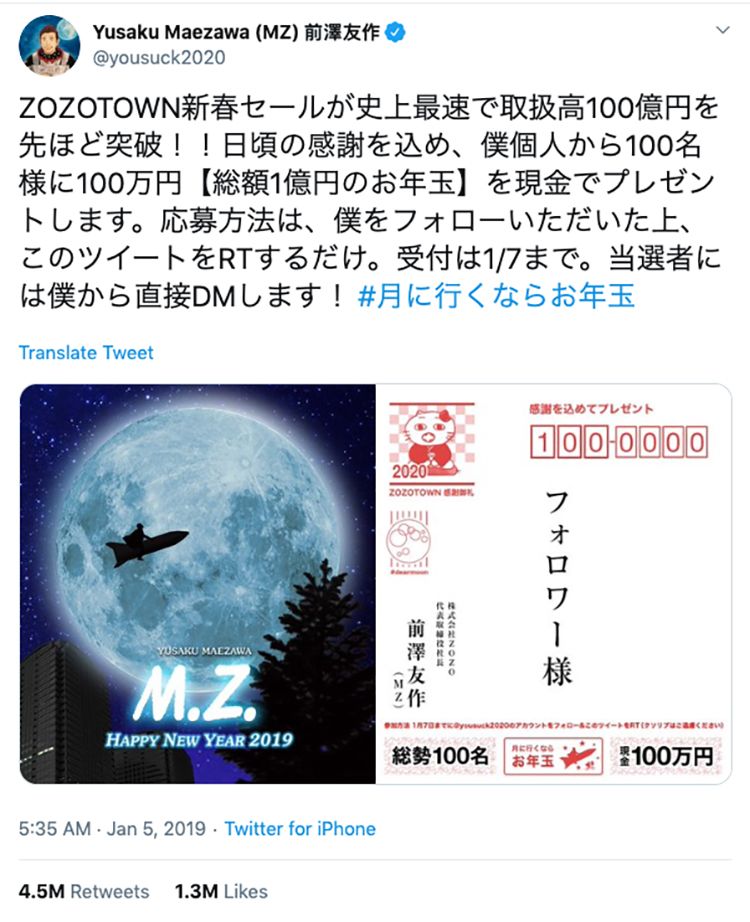
Source: Yusaku Maezawa’s Tweet
Using buzzwords to increase brand awareness
There are some unique buzzwords that have been explosive on Twitter in Japan. For example, the word “BARUSU” is very popular and has made record-breaking news on Twitter. It comes from the non-official tradition called the “BARUSU Festival”
Every year or two, Castle in the Sky, one of Studio Ghibli’s most popular animated movies, plays on national television. One year when it aired, people commented “BARUSU” on 2 channel, formerly one of the biggest online communities in Japan and similar to Reddit, at the same time the characters said it. After that incident, more and more joined in and it became known as the “BARUSU Festival”.
In 2009, a large mass of people commented “BARUSU” on 2 channel and its server went down. As the years passed, people began to tweet “BARUSU” instead of commenting on 2 channel. In 2013, the “BARUSU Festival” broke the record for tweets per second with 143,199 tweets in one second. For comparison, the average tweets per second on a normal day is 5,700.
Japanese automaker, SUBARU, took advantage of the “BASURU Festival” in a marketing campaign in 2016 as “BARUSU” is an anagram of “SUBARU”. They created and tweeted an interactive, Castle in the Sky themed gif in which users could stop the gif at the word “RUSUBA”, “SUBARU”, or “BARUSU”. The tweet has nearly 8K retweets and 3.2K likes, as of August 2019.
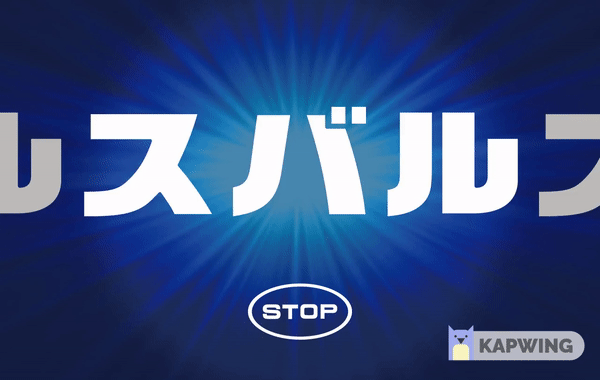
Source: @SUBARU_CORP
【Related Article】 Marketing in Japan – Shyness(?) and Urban Commuting Style
Instagram: A craze for finding “instagrammable” opportunities
Since Instagram launched in 2014 in Japan, its MAU in Japan has increased dramatically. Considering that Instagram has been in the Japanese market for only about 5 years, it has acquired quite a high portion of the younger population.
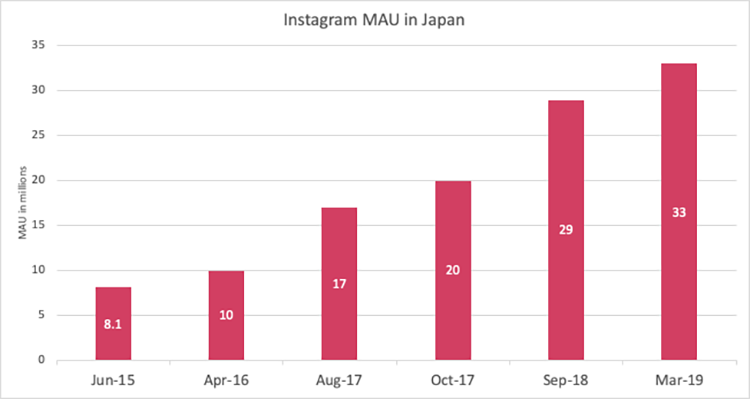
Source: uniad
Instagram User Characteristics
As you can see in the graph below, females are the dominant users in all of the age groups with the exception of those in their 60’s. From adolescents to those in their 30’s, female users use Instagram notably more than their male counterparts.
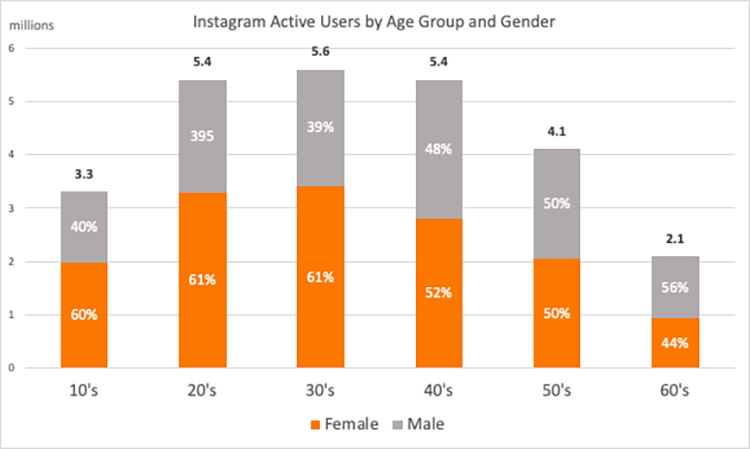
Source: FastaskReport, Social Media Lab
The graph above shows that Instagram is much more popular among the younger generations than the older generations.
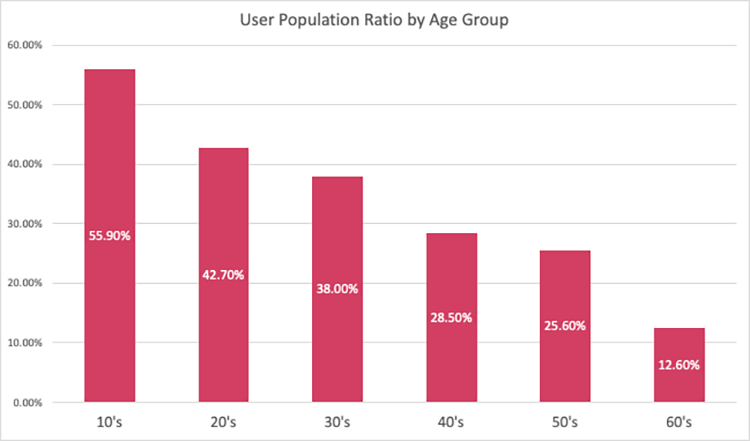
Source: FastaskReport, Social Media Lab
Looking at the graph above, it is obvious that the user distribution by age does not reflect the population in Japan further emphasizing that Instagram is more popular with the younger generation.
Instagram culture in Japan
The Japanese are obsessed with looking for “instagrammable” moments to capture. The Japanese word for “instagrammable” is インスタ映え (“instabae”). It is a combination of the words “Instagram” and “haeru” (or “baeru”), which means “to look pretty” in Japanese. Instagram users frequently use this word in their posts.
In 2017, “Instabae” was even nominated for the 流行語大賞(Ryu-kougo-taishow), which is an award for the best buzzword of the year. It goes to show that consumer behaviors are heavily influenced by whether a product or experience is “instagrammable.”
Just like users in other countries, many users, especially female users, are always looking for a chance to take a good picture for Instagram posts, whether they are eating, hanging out, or traveling. If you search “#インスタ映え” (#instabae) on Instagram, there are more than 6 million results. Along with “instabae”, you will find that “instabae cafe” or “instabae spot” are other popular buzzwords being used as hashtags in posts.
Oftentimes, people use photo filters and editing apps to make their photos and selfies more “instabae” material. Apps like Foodie, Snow, VSCO, SODA, Camera360, Adobe Lightroom, Ulike, and Meitu are popular among these users.
Although “instabae” photos of places and food are the most popular, text-heavy, magazine-like content inspired by physical magazines are gaining popularity among Japanese Instagram users as well.
https://www.instagram.com/p/B1OZjI6AHWZ/?utm_source=ig_web_copy_link
Magazine-style posts tend to get higher engagement because users need to swipe through the posts to read the content. Sometimes they even save the post to read it later. This style of posts is especially great for “how-to” types of content.
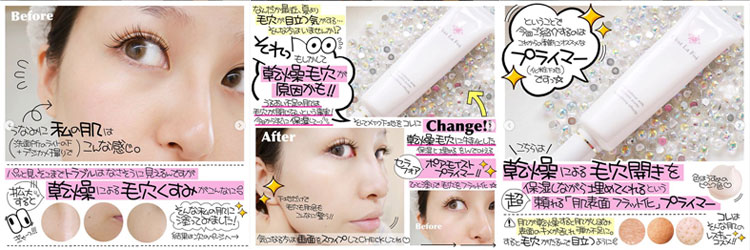
Photo credit: @330emi
Although Instagram is a visual content platform, it’s interesting that people not only enjoy browsing images, but also reading text in the magazine-style posts.
Facebook: Japan’s LinkedIn
Facebook has more than 2.3 billion MAU worldwide and has become one of the top social media platforms in many of the markets it has entered, with the exception of Japan. Facebook’s MAU has grown slowly since it launched in Japan in May 2008.
As you can see from the graph below, its growth has never really taken off. One of the reasons for Facebook’s slow growth is because the Japanese prefer to be anonymous and are more familiar with using social media platforms that don’t require users to use their actual names, such as mixi and GREE.
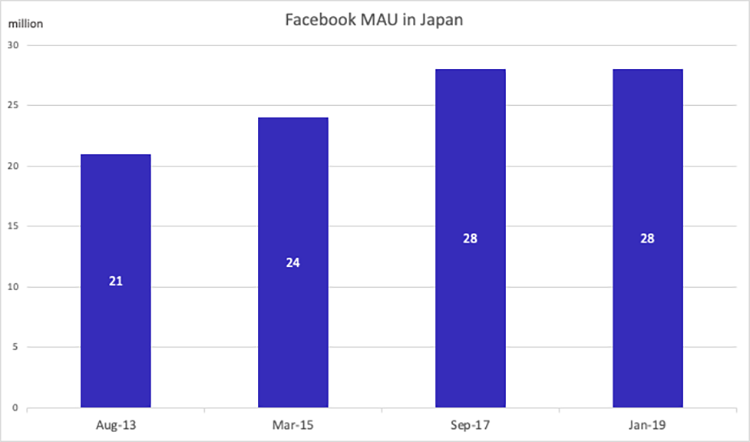
Facebook User Characteristics
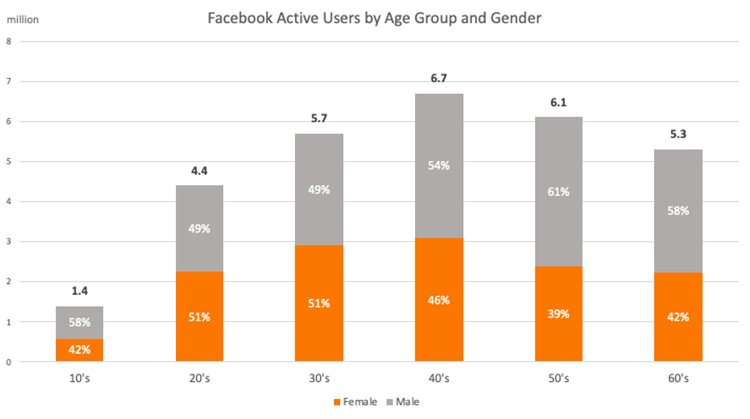
Source: FastaskReport, Social Media Lab
Looking at the graph above, you can see that the number of male users is slightly greater than female users. In comparison to the other social media platforms mentioned in this article, Facebook has many users in their 40’s to 60’s age groups.
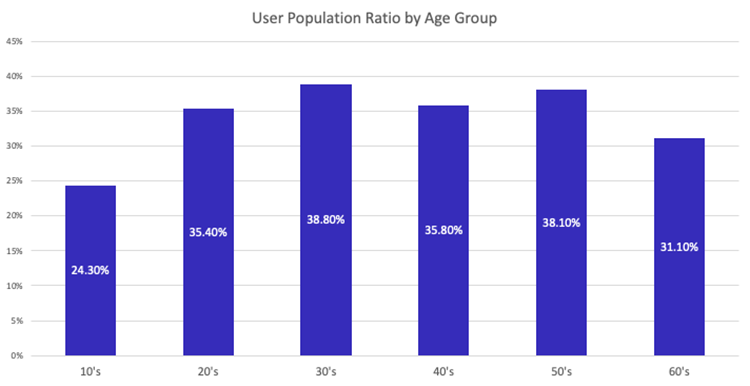
Source: FastaskReport, Social Media Lab
In looking at the graph above, you can see that approximately 35% of each age group, with the exception of teens, uses Facebook. With an older population of users, Facebook is mainly used before going to work and after coming back home.
People in Japan use Facebook similarly to how people in the U.S. use LinkedIn—as a platform to connect with business networks. More work-related content and public business announcements are posted on Facebook rather than posts for friends and family.
TikTok: For teens who long to become famous
TikTok is a newer social media platform that originated in China in September 2016. It officially started its service in Japan in August 2017. In the same year, it became a popular social media outlet among young females in Japan. According to a survey, one-quarter of young females in Japan are using the app.
Its MAU hit 9.5 million in the fourth quarter in 2018. However, TikTok hasn’t announced an updated number of its MAU since then. Considering how long it has been in the Japanese market, you can see how rapidly TikTok has grown.
【Related Article】TikTok’s rapid growth in Japan
TikTok User Characteristics
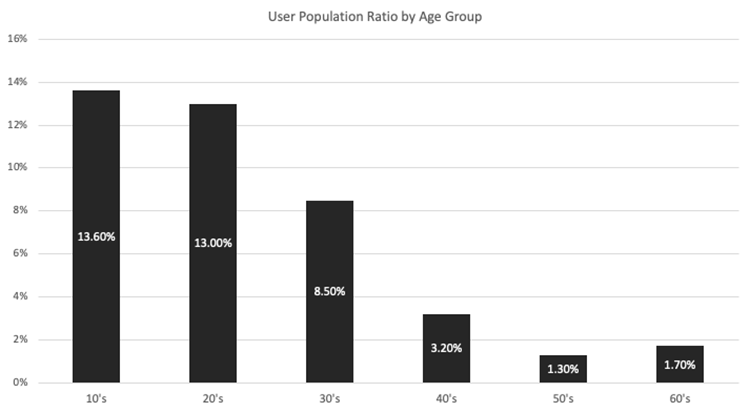
Source: iPhone Mania
There are many users in their teens and 20’s, making it a great platform to connect with the younger generation. However, a media source has stated concerns with the growing population of users in their 40’s, which could lead to a decrease in popularity among the younger generation.
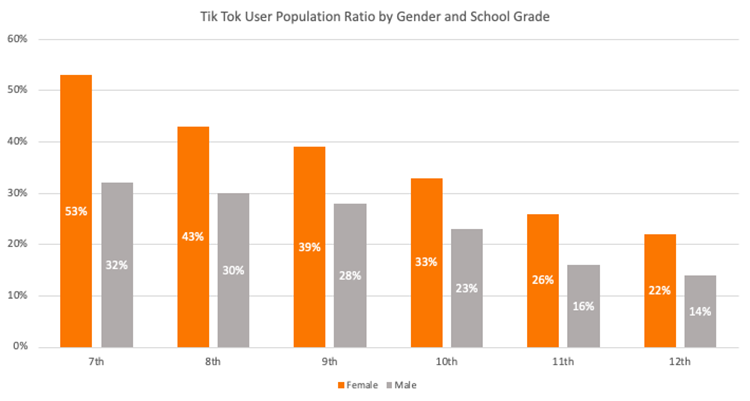
Source: impress Business Media
Looking at the chart above, the female user population is remarkably higher than the male user population in every grade. Moreover, the fact that there are younger users is important to note as they drive the continuous increase in TikTok’s success, showing the impact of younger generations in how they can be influential to social media growth.
TikTok is ideal for younger students
Since the internet is public, the Japanese feel that the content they put there will be permanent and “official”. This makes the Japanese uncomfortable, especially if their name is shown along with it because the Japanese prefer to be anonymous.
The younger generation, like Generation Z, especially dislike the “digital tattoo” of a status, picture, etc. posted on the internet because they don’t want to face any “consequences” they may receive from a post. Therefore, social media platforms designed for temporary, short, and lighthearted content, such as TikTok or Snapchat, are much more preferred.
According to a survey, the younger generation thinks that 10 to 15 minute videos on YouTube are too long. Therefore, short videos on TikTok are preferred. Remarkably, 53% of female students in the 7th grade actively use TikTok. It is more popular among female students because they are more interested in keeping up with the latest trends than male students.
Understanding the influence of TikTok
TikTok challenges became very popular for middle and high school students in 2017 because many users preferred making videos with others. According to a survey, 24% of respondents claimed that they enjoy posting videos with friends while 46% of respondents made the statement, “I’m not comfortable with posting a video all by myself.”
TikTok challenges are very powerful as they create a strong community for the users. If you’re looking to use TikTok in your social media strategy, keep an eye on popular “challenges” students try with their friends as it may spark the next viral video.
TikTok is so popular that “micro-celebrities” are created through the platform. These celebrities are called “TikTokers”. Some of the more popular TikTokers have been recruited by talent agencies. Even one of the biggest record label companies in Japan, Avex, partnered up with TikTok in October 2018. With more opportunities, the partnership could accelerate TikTok’s growth in the future.
Summary
When expanding to Japan it is important to think about what social media platforms your customers are on. Including social media in your marketing strategy is one aspect of a successful entry and you need to make sure you understand the social media trends in Japan. Confirm that you are using the right social media platform to connect with your target audience. As we discussed the top 5 social media platforms in Japan, you can see each platform’s audience is quite different from one another.
LINE is significantly different from other social media platforms in Japan as it offers robust services for all different age groups and it has the highest adoption rate. If you want to target the younger generation, TikTok or Instagram may be the way to go because of their popularity with younger users. Conversely, if you prefer to target an older audience, Facebook may be the way to go.
#####
Social media only constitutes a fraction of your Japanese marketing strategy. To be successful in Japan, you need to be very familiar with your target customers and have done the needed research on Japanese business and culture. btrax is here to help you do the necessary research to create a market entry strategy, localize your product/service, and market to your customers. Feel free to contact us if you have any questions about marketing in Japan. If you found this article useful and want more, sign up for our newsletter! We look forward to hearing from you.
Edit by: Julie Saephan







